IS1: Risk Management Plan for The Wesley Hospital Building Project
VerifiedAdded on 2023/01/04
|8
|2090
|49
Report
AI Summary
This report provides a comprehensive analysis of risk management within the context of a hospital building project undertaken by The Wesley Hospital in Gold Coast. It explores various project delivery methods, including Design-Bid-Build, Design-Build, and Construction Management-at-Risk, recommending a contractor-led design building approach. The report then delves into financial contract types such as Lump sum, Guaranteed Maximum Price, and Cost-Plus Fixed Fee contracts, advocating for the Cost-Plus Fixed Fee contract due to its flexibility. Furthermore, it examines different procurement methods like Competitive, Negotiated, and Best Value, suggesting the Negotiated procurement method. A detailed risk management plan is presented, encompassing risk identification, risk quadrant analysis (financial, strategic, hazard, and operational risks), and a risk mitigation plan. The report concludes by emphasizing the importance of proactive risk management in construction projects to mitigate negative impacts. References to relevant literature are also included.
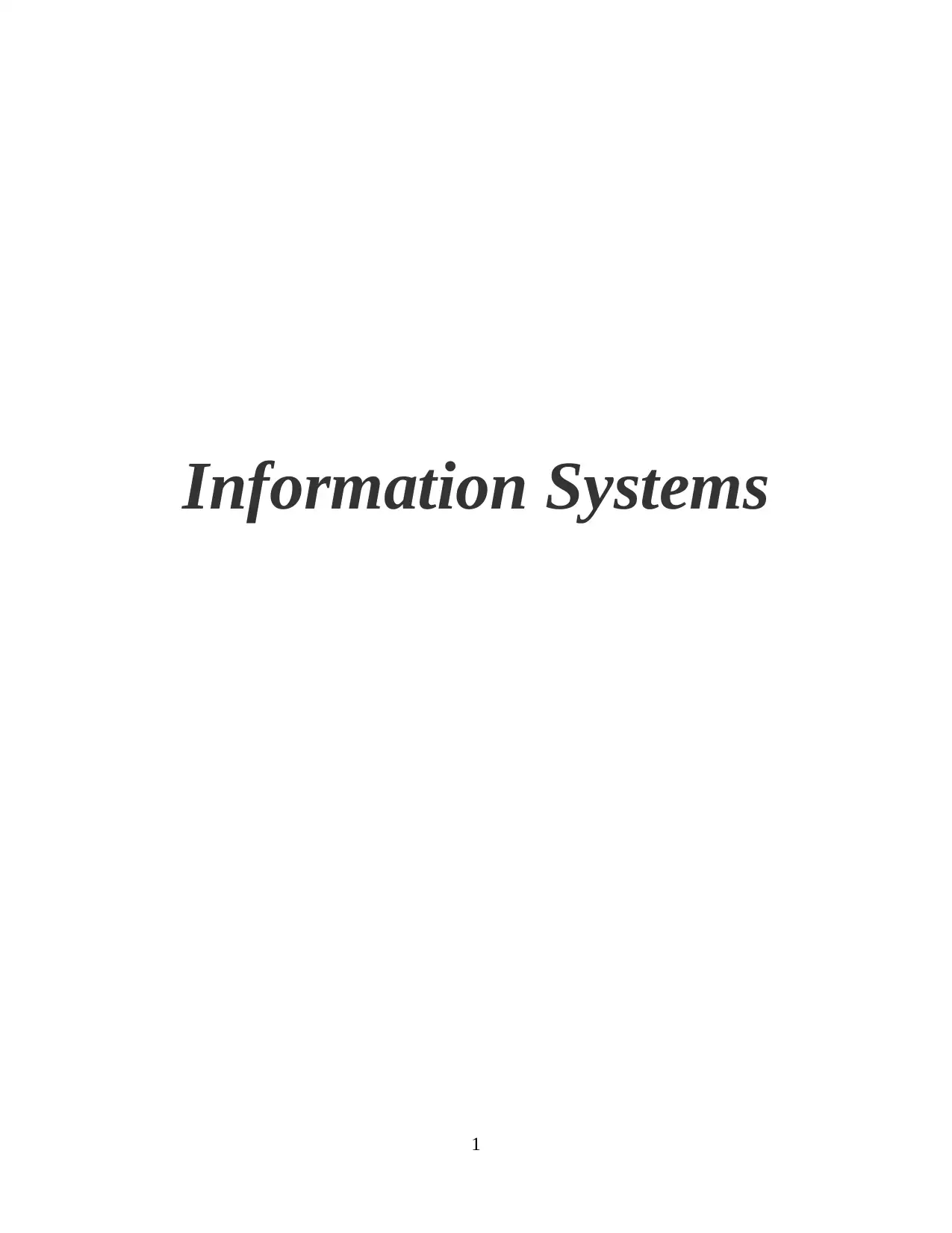
Information Systems
1
1
Paraphrase This Document
Need a fresh take? Get an instant paraphrase of this document with our AI Paraphraser
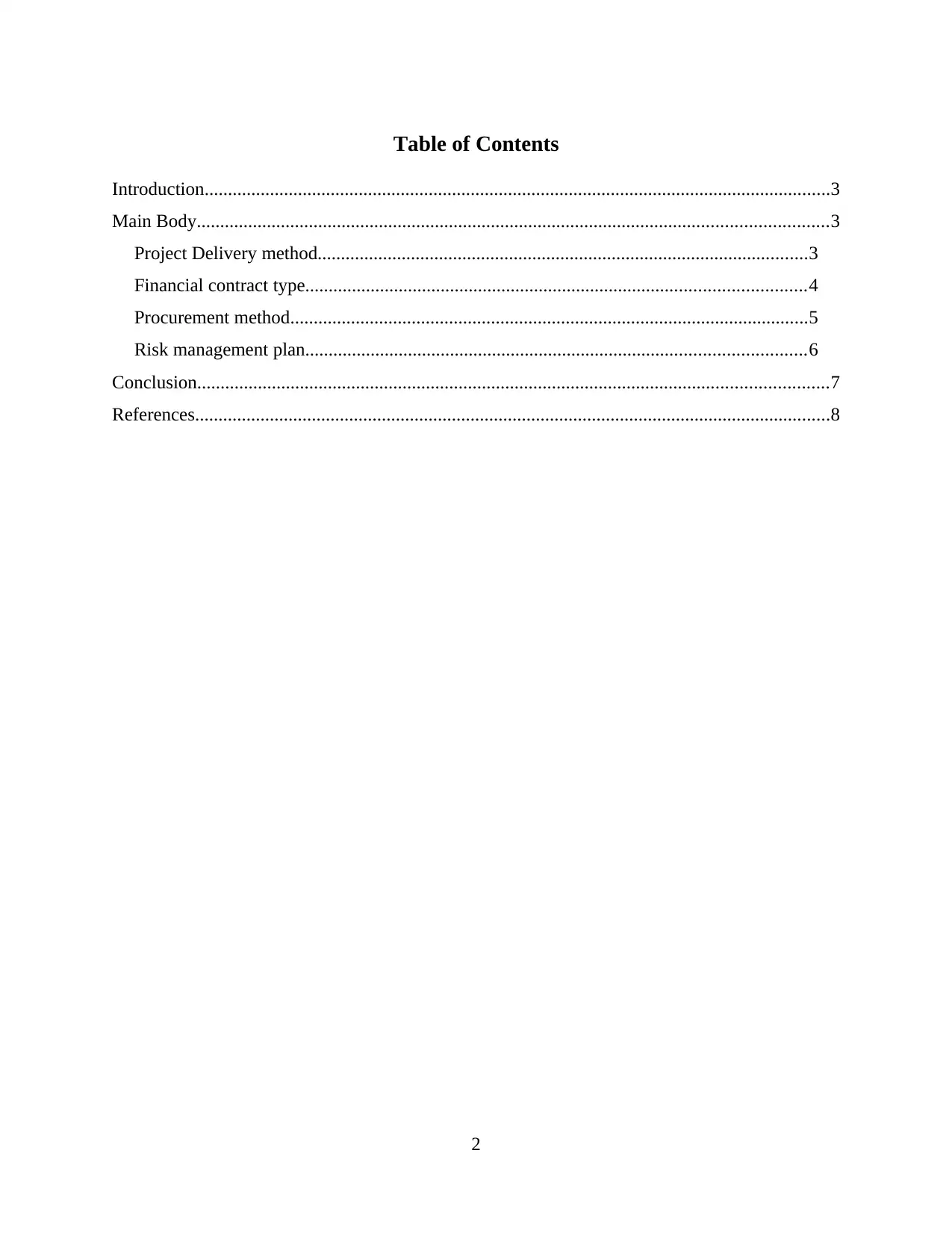
Table of Contents
Introduction......................................................................................................................................3
Main Body.......................................................................................................................................3
Project Delivery method.........................................................................................................3
Financial contract type...........................................................................................................4
Procurement method...............................................................................................................5
Risk management plan...........................................................................................................6
Conclusion.......................................................................................................................................7
References........................................................................................................................................8
2
Introduction......................................................................................................................................3
Main Body.......................................................................................................................................3
Project Delivery method.........................................................................................................3
Financial contract type...........................................................................................................4
Procurement method...............................................................................................................5
Risk management plan...........................................................................................................6
Conclusion.......................................................................................................................................7
References........................................................................................................................................8
2
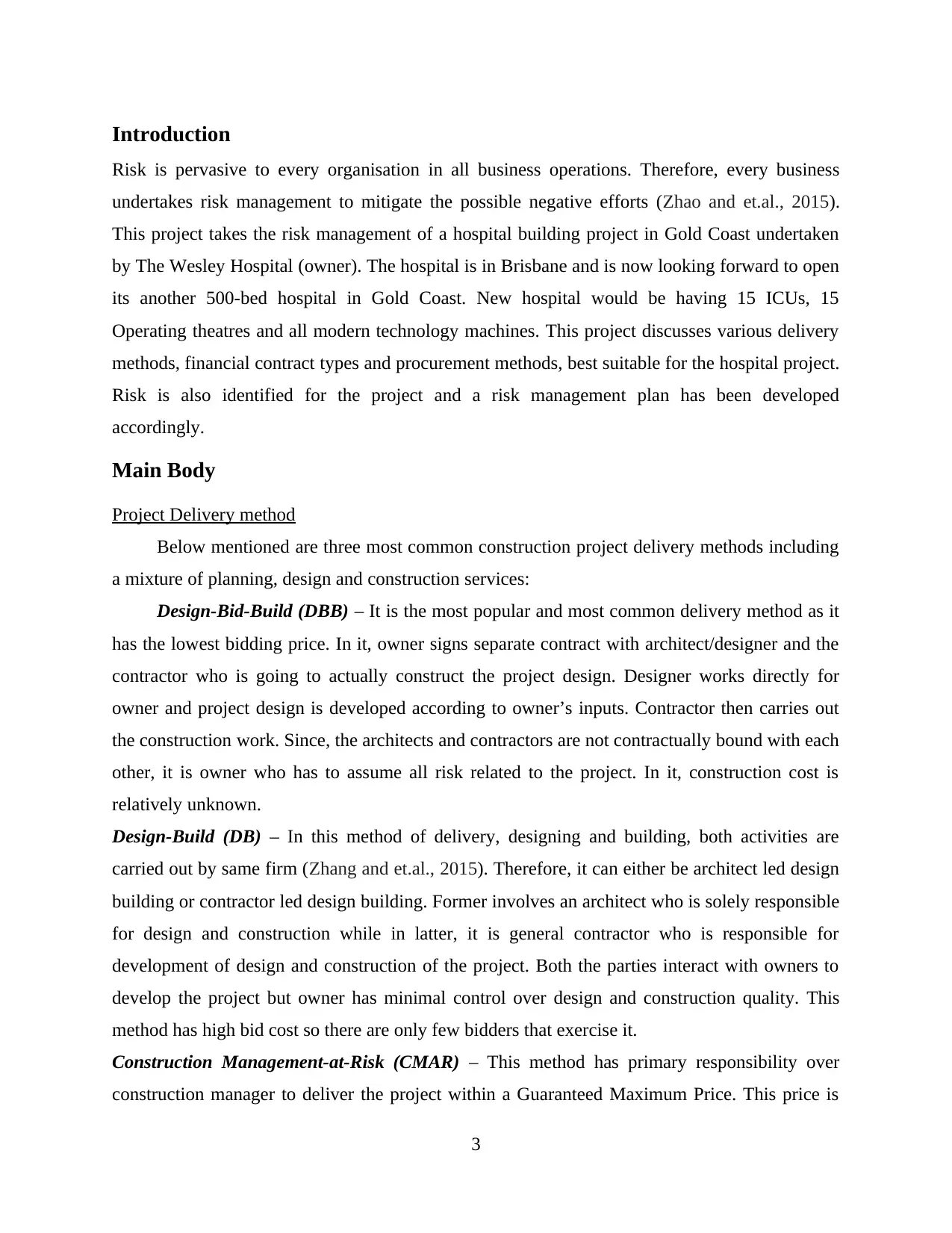
Introduction
Risk is pervasive to every organisation in all business operations. Therefore, every business
undertakes risk management to mitigate the possible negative efforts (Zhao and et.al., 2015).
This project takes the risk management of a hospital building project in Gold Coast undertaken
by The Wesley Hospital (owner). The hospital is in Brisbane and is now looking forward to open
its another 500-bed hospital in Gold Coast. New hospital would be having 15 ICUs, 15
Operating theatres and all modern technology machines. This project discusses various delivery
methods, financial contract types and procurement methods, best suitable for the hospital project.
Risk is also identified for the project and a risk management plan has been developed
accordingly.
Main Body
Project Delivery method
Below mentioned are three most common construction project delivery methods including
a mixture of planning, design and construction services:
Design-Bid-Build (DBB) – It is the most popular and most common delivery method as it
has the lowest bidding price. In it, owner signs separate contract with architect/designer and the
contractor who is going to actually construct the project design. Designer works directly for
owner and project design is developed according to owner’s inputs. Contractor then carries out
the construction work. Since, the architects and contractors are not contractually bound with each
other, it is owner who has to assume all risk related to the project. In it, construction cost is
relatively unknown.
Design-Build (DB) – In this method of delivery, designing and building, both activities are
carried out by same firm (Zhang and et.al., 2015). Therefore, it can either be architect led design
building or contractor led design building. Former involves an architect who is solely responsible
for design and construction while in latter, it is general contractor who is responsible for
development of design and construction of the project. Both the parties interact with owners to
develop the project but owner has minimal control over design and construction quality. This
method has high bid cost so there are only few bidders that exercise it.
Construction Management-at-Risk (CMAR) – This method has primary responsibility over
construction manager to deliver the project within a Guaranteed Maximum Price. This price is
3
Risk is pervasive to every organisation in all business operations. Therefore, every business
undertakes risk management to mitigate the possible negative efforts (Zhao and et.al., 2015).
This project takes the risk management of a hospital building project in Gold Coast undertaken
by The Wesley Hospital (owner). The hospital is in Brisbane and is now looking forward to open
its another 500-bed hospital in Gold Coast. New hospital would be having 15 ICUs, 15
Operating theatres and all modern technology machines. This project discusses various delivery
methods, financial contract types and procurement methods, best suitable for the hospital project.
Risk is also identified for the project and a risk management plan has been developed
accordingly.
Main Body
Project Delivery method
Below mentioned are three most common construction project delivery methods including
a mixture of planning, design and construction services:
Design-Bid-Build (DBB) – It is the most popular and most common delivery method as it
has the lowest bidding price. In it, owner signs separate contract with architect/designer and the
contractor who is going to actually construct the project design. Designer works directly for
owner and project design is developed according to owner’s inputs. Contractor then carries out
the construction work. Since, the architects and contractors are not contractually bound with each
other, it is owner who has to assume all risk related to the project. In it, construction cost is
relatively unknown.
Design-Build (DB) – In this method of delivery, designing and building, both activities are
carried out by same firm (Zhang and et.al., 2015). Therefore, it can either be architect led design
building or contractor led design building. Former involves an architect who is solely responsible
for design and construction while in latter, it is general contractor who is responsible for
development of design and construction of the project. Both the parties interact with owners to
develop the project but owner has minimal control over design and construction quality. This
method has high bid cost so there are only few bidders that exercise it.
Construction Management-at-Risk (CMAR) – This method has primary responsibility over
construction manager to deliver the project within a Guaranteed Maximum Price. This price is
3
⊘ This is a preview!⊘
Do you want full access?
Subscribe today to unlock all pages.

Trusted by 1+ million students worldwide
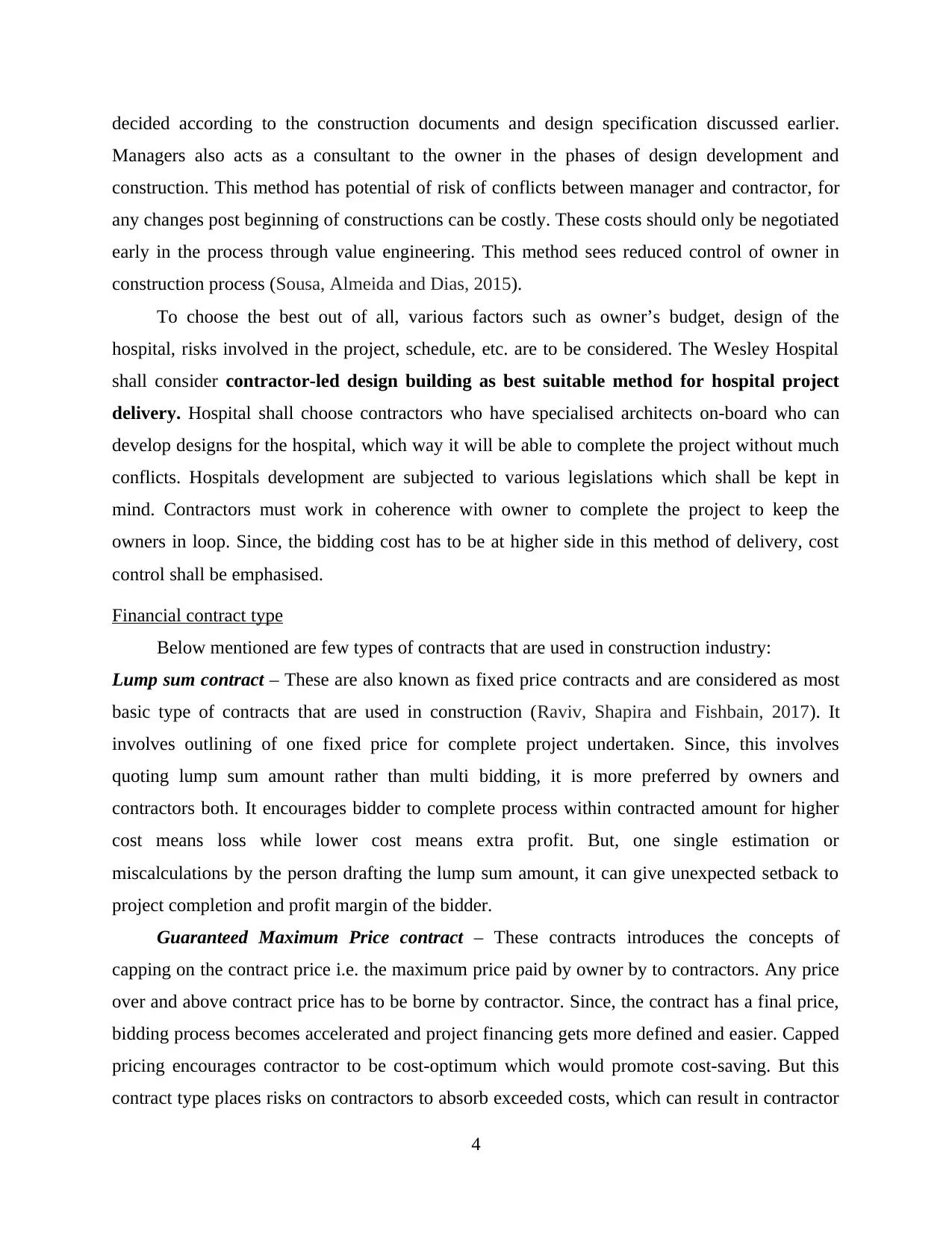
decided according to the construction documents and design specification discussed earlier.
Managers also acts as a consultant to the owner in the phases of design development and
construction. This method has potential of risk of conflicts between manager and contractor, for
any changes post beginning of constructions can be costly. These costs should only be negotiated
early in the process through value engineering. This method sees reduced control of owner in
construction process (Sousa, Almeida and Dias, 2015).
To choose the best out of all, various factors such as owner’s budget, design of the
hospital, risks involved in the project, schedule, etc. are to be considered. The Wesley Hospital
shall consider contractor-led design building as best suitable method for hospital project
delivery. Hospital shall choose contractors who have specialised architects on-board who can
develop designs for the hospital, which way it will be able to complete the project without much
conflicts. Hospitals development are subjected to various legislations which shall be kept in
mind. Contractors must work in coherence with owner to complete the project to keep the
owners in loop. Since, the bidding cost has to be at higher side in this method of delivery, cost
control shall be emphasised.
Financial contract type
Below mentioned are few types of contracts that are used in construction industry:
Lump sum contract – These are also known as fixed price contracts and are considered as most
basic type of contracts that are used in construction (Raviv, Shapira and Fishbain, 2017). It
involves outlining of one fixed price for complete project undertaken. Since, this involves
quoting lump sum amount rather than multi bidding, it is more preferred by owners and
contractors both. It encourages bidder to complete process within contracted amount for higher
cost means loss while lower cost means extra profit. But, one single estimation or
miscalculations by the person drafting the lump sum amount, it can give unexpected setback to
project completion and profit margin of the bidder.
Guaranteed Maximum Price contract – These contracts introduces the concepts of
capping on the contract price i.e. the maximum price paid by owner by to contractors. Any price
over and above contract price has to be borne by contractor. Since, the contract has a final price,
bidding process becomes accelerated and project financing gets more defined and easier. Capped
pricing encourages contractor to be cost-optimum which would promote cost-saving. But this
contract type places risks on contractors to absorb exceeded costs, which can result in contractor
4
Managers also acts as a consultant to the owner in the phases of design development and
construction. This method has potential of risk of conflicts between manager and contractor, for
any changes post beginning of constructions can be costly. These costs should only be negotiated
early in the process through value engineering. This method sees reduced control of owner in
construction process (Sousa, Almeida and Dias, 2015).
To choose the best out of all, various factors such as owner’s budget, design of the
hospital, risks involved in the project, schedule, etc. are to be considered. The Wesley Hospital
shall consider contractor-led design building as best suitable method for hospital project
delivery. Hospital shall choose contractors who have specialised architects on-board who can
develop designs for the hospital, which way it will be able to complete the project without much
conflicts. Hospitals development are subjected to various legislations which shall be kept in
mind. Contractors must work in coherence with owner to complete the project to keep the
owners in loop. Since, the bidding cost has to be at higher side in this method of delivery, cost
control shall be emphasised.
Financial contract type
Below mentioned are few types of contracts that are used in construction industry:
Lump sum contract – These are also known as fixed price contracts and are considered as most
basic type of contracts that are used in construction (Raviv, Shapira and Fishbain, 2017). It
involves outlining of one fixed price for complete project undertaken. Since, this involves
quoting lump sum amount rather than multi bidding, it is more preferred by owners and
contractors both. It encourages bidder to complete process within contracted amount for higher
cost means loss while lower cost means extra profit. But, one single estimation or
miscalculations by the person drafting the lump sum amount, it can give unexpected setback to
project completion and profit margin of the bidder.
Guaranteed Maximum Price contract – These contracts introduces the concepts of
capping on the contract price i.e. the maximum price paid by owner by to contractors. Any price
over and above contract price has to be borne by contractor. Since, the contract has a final price,
bidding process becomes accelerated and project financing gets more defined and easier. Capped
pricing encourages contractor to be cost-optimum which would promote cost-saving. But this
contract type places risks on contractors to absorb exceeded costs, which can result in contractor
4
Paraphrase This Document
Need a fresh take? Get an instant paraphrase of this document with our AI Paraphraser
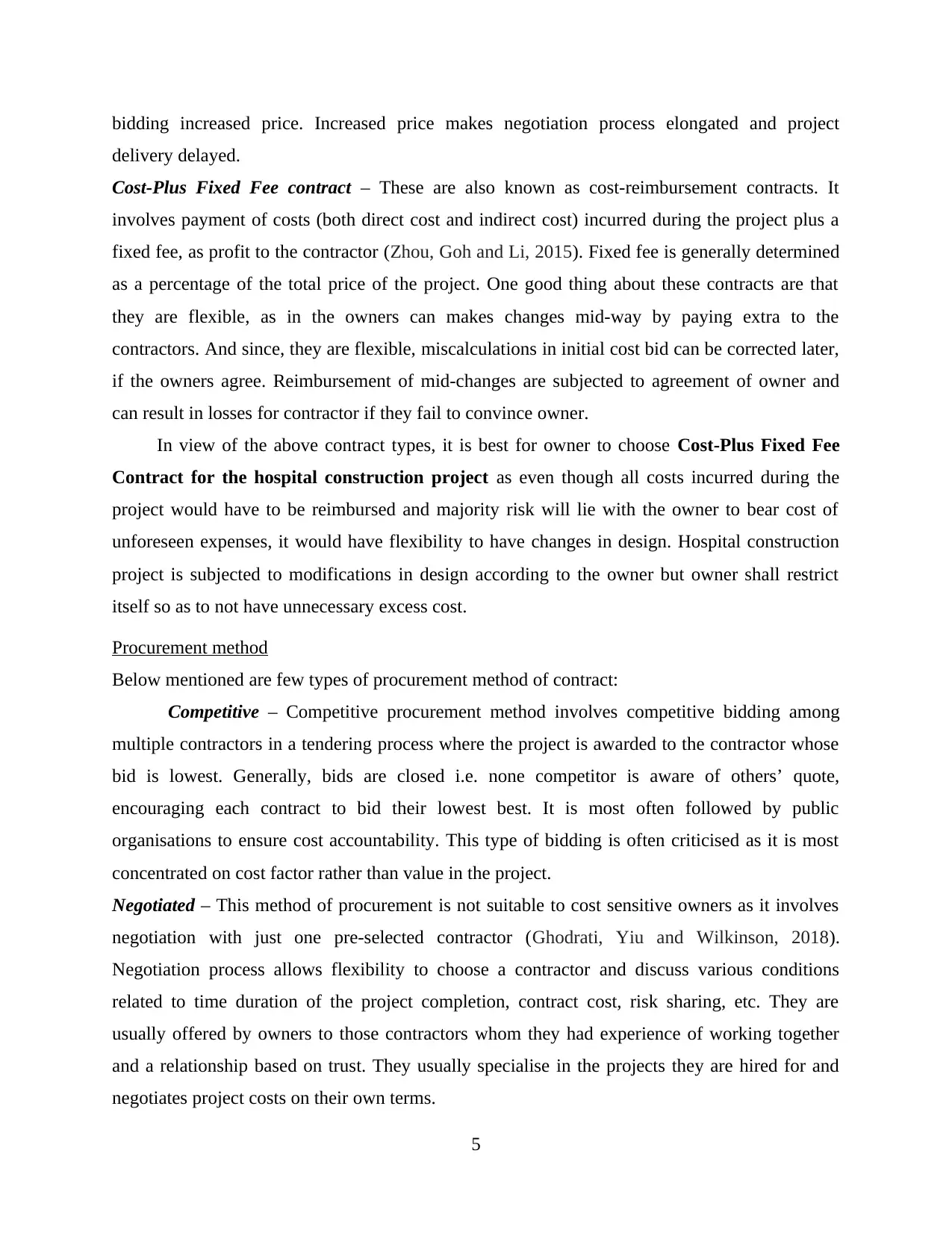
bidding increased price. Increased price makes negotiation process elongated and project
delivery delayed.
Cost-Plus Fixed Fee contract – These are also known as cost-reimbursement contracts. It
involves payment of costs (both direct cost and indirect cost) incurred during the project plus a
fixed fee, as profit to the contractor (Zhou, Goh and Li, 2015). Fixed fee is generally determined
as a percentage of the total price of the project. One good thing about these contracts are that
they are flexible, as in the owners can makes changes mid-way by paying extra to the
contractors. And since, they are flexible, miscalculations in initial cost bid can be corrected later,
if the owners agree. Reimbursement of mid-changes are subjected to agreement of owner and
can result in losses for contractor if they fail to convince owner.
In view of the above contract types, it is best for owner to choose Cost-Plus Fixed Fee
Contract for the hospital construction project as even though all costs incurred during the
project would have to be reimbursed and majority risk will lie with the owner to bear cost of
unforeseen expenses, it would have flexibility to have changes in design. Hospital construction
project is subjected to modifications in design according to the owner but owner shall restrict
itself so as to not have unnecessary excess cost.
Procurement method
Below mentioned are few types of procurement method of contract:
Competitive – Competitive procurement method involves competitive bidding among
multiple contractors in a tendering process where the project is awarded to the contractor whose
bid is lowest. Generally, bids are closed i.e. none competitor is aware of others’ quote,
encouraging each contract to bid their lowest best. It is most often followed by public
organisations to ensure cost accountability. This type of bidding is often criticised as it is most
concentrated on cost factor rather than value in the project.
Negotiated – This method of procurement is not suitable to cost sensitive owners as it involves
negotiation with just one pre-selected contractor (Ghodrati, Yiu and Wilkinson, 2018).
Negotiation process allows flexibility to choose a contractor and discuss various conditions
related to time duration of the project completion, contract cost, risk sharing, etc. They are
usually offered by owners to those contractors whom they had experience of working together
and a relationship based on trust. They usually specialise in the projects they are hired for and
negotiates project costs on their own terms.
5
delivery delayed.
Cost-Plus Fixed Fee contract – These are also known as cost-reimbursement contracts. It
involves payment of costs (both direct cost and indirect cost) incurred during the project plus a
fixed fee, as profit to the contractor (Zhou, Goh and Li, 2015). Fixed fee is generally determined
as a percentage of the total price of the project. One good thing about these contracts are that
they are flexible, as in the owners can makes changes mid-way by paying extra to the
contractors. And since, they are flexible, miscalculations in initial cost bid can be corrected later,
if the owners agree. Reimbursement of mid-changes are subjected to agreement of owner and
can result in losses for contractor if they fail to convince owner.
In view of the above contract types, it is best for owner to choose Cost-Plus Fixed Fee
Contract for the hospital construction project as even though all costs incurred during the
project would have to be reimbursed and majority risk will lie with the owner to bear cost of
unforeseen expenses, it would have flexibility to have changes in design. Hospital construction
project is subjected to modifications in design according to the owner but owner shall restrict
itself so as to not have unnecessary excess cost.
Procurement method
Below mentioned are few types of procurement method of contract:
Competitive – Competitive procurement method involves competitive bidding among
multiple contractors in a tendering process where the project is awarded to the contractor whose
bid is lowest. Generally, bids are closed i.e. none competitor is aware of others’ quote,
encouraging each contract to bid their lowest best. It is most often followed by public
organisations to ensure cost accountability. This type of bidding is often criticised as it is most
concentrated on cost factor rather than value in the project.
Negotiated – This method of procurement is not suitable to cost sensitive owners as it involves
negotiation with just one pre-selected contractor (Ghodrati, Yiu and Wilkinson, 2018).
Negotiation process allows flexibility to choose a contractor and discuss various conditions
related to time duration of the project completion, contract cost, risk sharing, etc. They are
usually offered by owners to those contractors whom they had experience of working together
and a relationship based on trust. They usually specialise in the projects they are hired for and
negotiates project costs on their own terms.
5
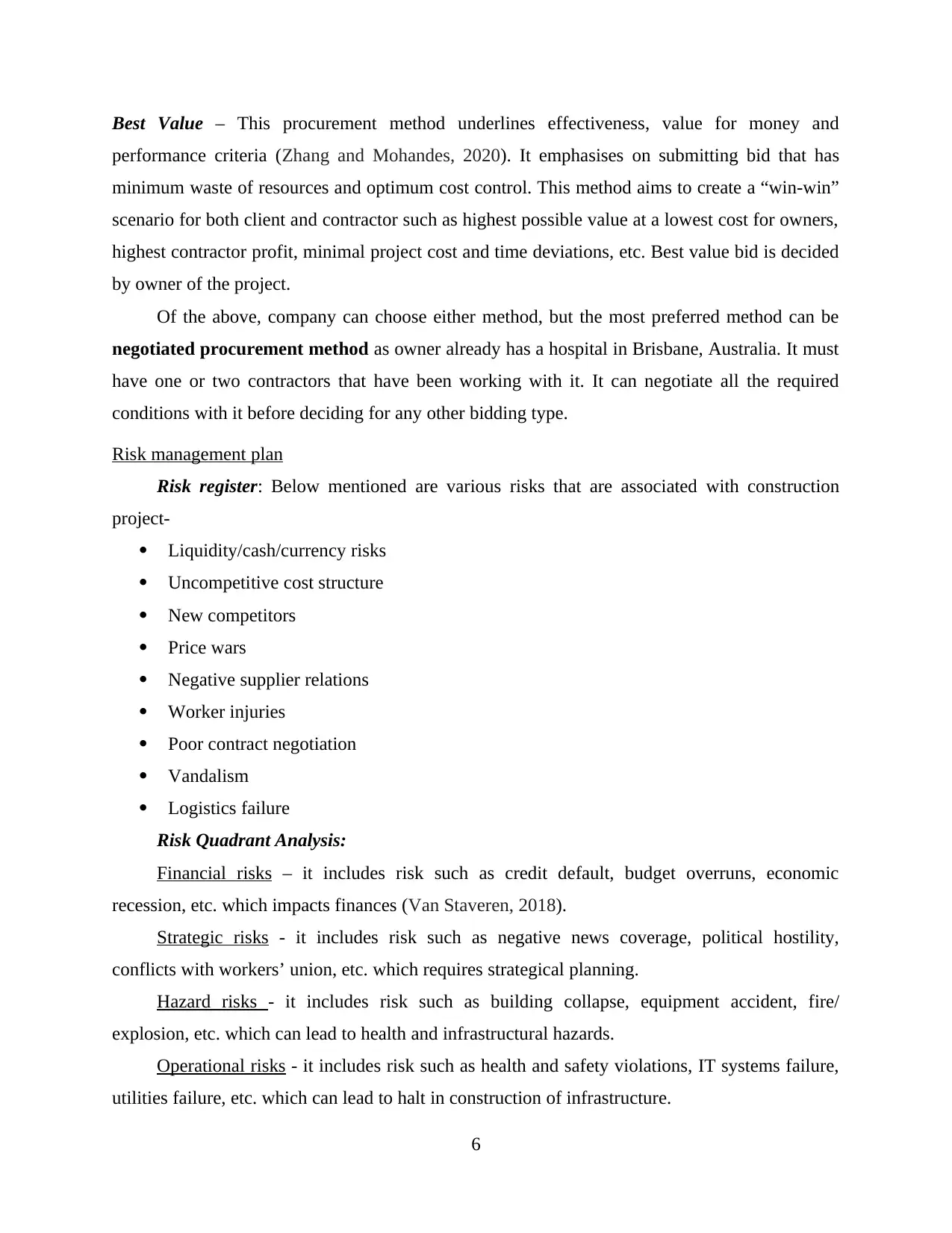
Best Value – This procurement method underlines effectiveness, value for money and
performance criteria (Zhang and Mohandes, 2020). It emphasises on submitting bid that has
minimum waste of resources and optimum cost control. This method aims to create a “win-win”
scenario for both client and contractor such as highest possible value at a lowest cost for owners,
highest contractor profit, minimal project cost and time deviations, etc. Best value bid is decided
by owner of the project.
Of the above, company can choose either method, but the most preferred method can be
negotiated procurement method as owner already has a hospital in Brisbane, Australia. It must
have one or two contractors that have been working with it. It can negotiate all the required
conditions with it before deciding for any other bidding type.
Risk management plan
Risk register: Below mentioned are various risks that are associated with construction
project-
Liquidity/cash/currency risks
Uncompetitive cost structure
New competitors
Price wars
Negative supplier relations
Worker injuries
Poor contract negotiation
Vandalism
Logistics failure
Risk Quadrant Analysis:
Financial risks – it includes risk such as credit default, budget overruns, economic
recession, etc. which impacts finances (Van Staveren, 2018).
Strategic risks - it includes risk such as negative news coverage, political hostility,
conflicts with workers’ union, etc. which requires strategical planning.
Hazard risks - it includes risk such as building collapse, equipment accident, fire/
explosion, etc. which can lead to health and infrastructural hazards.
Operational risks - it includes risk such as health and safety violations, IT systems failure,
utilities failure, etc. which can lead to halt in construction of infrastructure.
6
performance criteria (Zhang and Mohandes, 2020). It emphasises on submitting bid that has
minimum waste of resources and optimum cost control. This method aims to create a “win-win”
scenario for both client and contractor such as highest possible value at a lowest cost for owners,
highest contractor profit, minimal project cost and time deviations, etc. Best value bid is decided
by owner of the project.
Of the above, company can choose either method, but the most preferred method can be
negotiated procurement method as owner already has a hospital in Brisbane, Australia. It must
have one or two contractors that have been working with it. It can negotiate all the required
conditions with it before deciding for any other bidding type.
Risk management plan
Risk register: Below mentioned are various risks that are associated with construction
project-
Liquidity/cash/currency risks
Uncompetitive cost structure
New competitors
Price wars
Negative supplier relations
Worker injuries
Poor contract negotiation
Vandalism
Logistics failure
Risk Quadrant Analysis:
Financial risks – it includes risk such as credit default, budget overruns, economic
recession, etc. which impacts finances (Van Staveren, 2018).
Strategic risks - it includes risk such as negative news coverage, political hostility,
conflicts with workers’ union, etc. which requires strategical planning.
Hazard risks - it includes risk such as building collapse, equipment accident, fire/
explosion, etc. which can lead to health and infrastructural hazards.
Operational risks - it includes risk such as health and safety violations, IT systems failure,
utilities failure, etc. which can lead to halt in construction of infrastructure.
6
⊘ This is a preview!⊘
Do you want full access?
Subscribe today to unlock all pages.

Trusted by 1+ million students worldwide
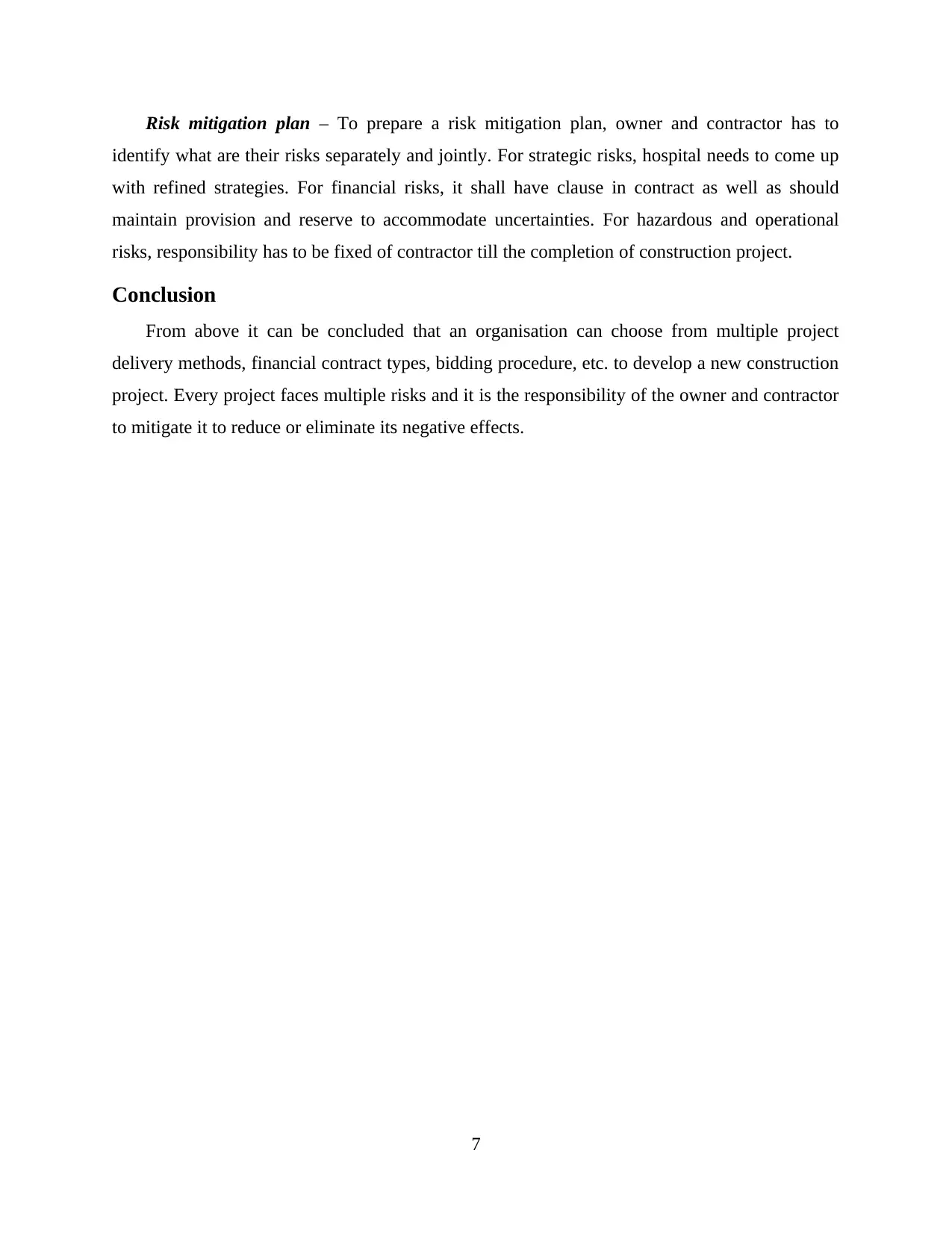
Risk mitigation plan – To prepare a risk mitigation plan, owner and contractor has to
identify what are their risks separately and jointly. For strategic risks, hospital needs to come up
with refined strategies. For financial risks, it shall have clause in contract as well as should
maintain provision and reserve to accommodate uncertainties. For hazardous and operational
risks, responsibility has to be fixed of contractor till the completion of construction project.
Conclusion
From above it can be concluded that an organisation can choose from multiple project
delivery methods, financial contract types, bidding procedure, etc. to develop a new construction
project. Every project faces multiple risks and it is the responsibility of the owner and contractor
to mitigate it to reduce or eliminate its negative effects.
7
identify what are their risks separately and jointly. For strategic risks, hospital needs to come up
with refined strategies. For financial risks, it shall have clause in contract as well as should
maintain provision and reserve to accommodate uncertainties. For hazardous and operational
risks, responsibility has to be fixed of contractor till the completion of construction project.
Conclusion
From above it can be concluded that an organisation can choose from multiple project
delivery methods, financial contract types, bidding procedure, etc. to develop a new construction
project. Every project faces multiple risks and it is the responsibility of the owner and contractor
to mitigate it to reduce or eliminate its negative effects.
7
Paraphrase This Document
Need a fresh take? Get an instant paraphrase of this document with our AI Paraphraser
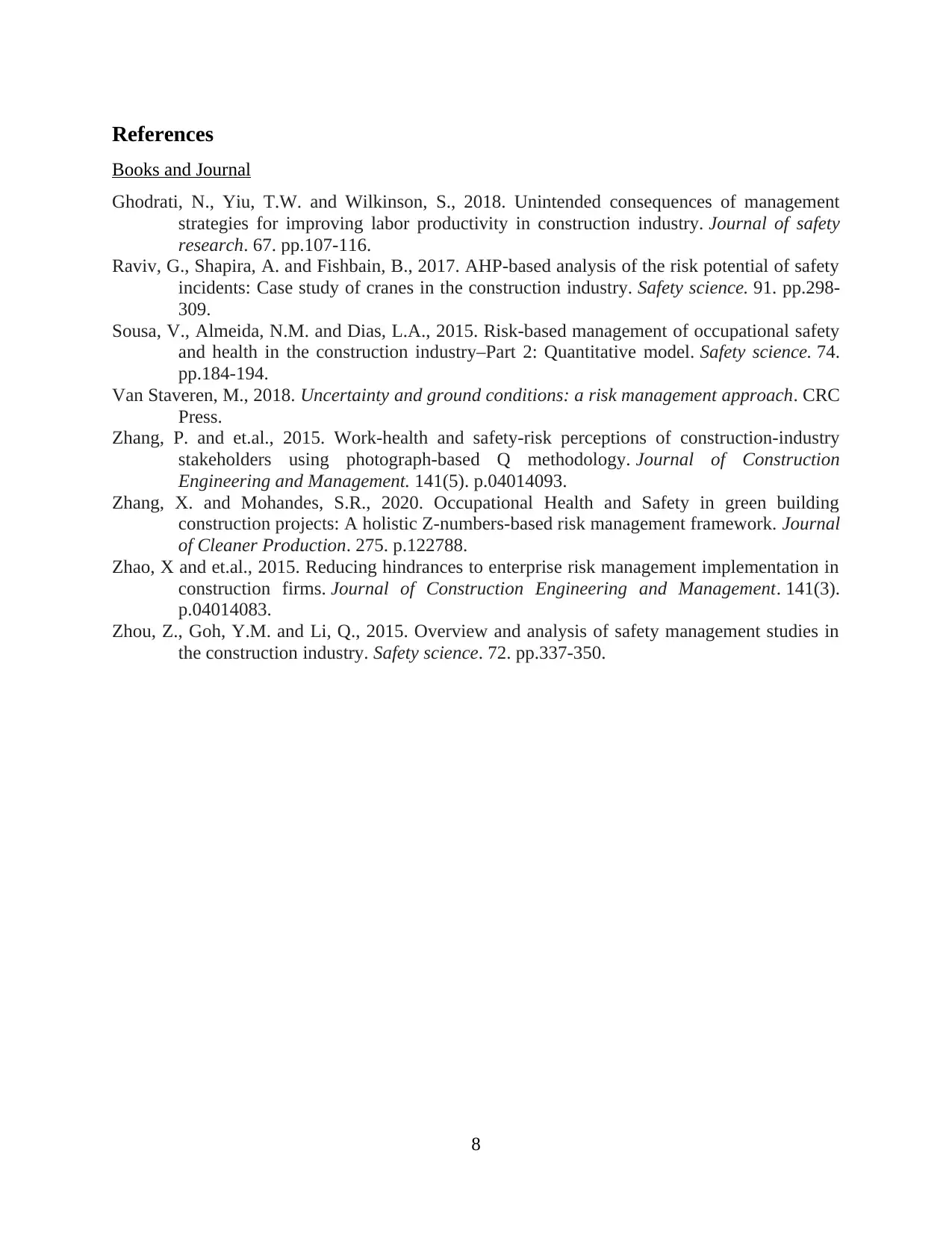
References
Books and Journal
Ghodrati, N., Yiu, T.W. and Wilkinson, S., 2018. Unintended consequences of management
strategies for improving labor productivity in construction industry. Journal of safety
research. 67. pp.107-116.
Raviv, G., Shapira, A. and Fishbain, B., 2017. AHP-based analysis of the risk potential of safety
incidents: Case study of cranes in the construction industry. Safety science. 91. pp.298-
309.
Sousa, V., Almeida, N.M. and Dias, L.A., 2015. Risk-based management of occupational safety
and health in the construction industry–Part 2: Quantitative model. Safety science. 74.
pp.184-194.
Van Staveren, M., 2018. Uncertainty and ground conditions: a risk management approach. CRC
Press.
Zhang, P. and et.al., 2015. Work-health and safety-risk perceptions of construction-industry
stakeholders using photograph-based Q methodology. Journal of Construction
Engineering and Management. 141(5). p.04014093.
Zhang, X. and Mohandes, S.R., 2020. Occupational Health and Safety in green building
construction projects: A holistic Z-numbers-based risk management framework. Journal
of Cleaner Production. 275. p.122788.
Zhao, X and et.al., 2015. Reducing hindrances to enterprise risk management implementation in
construction firms. Journal of Construction Engineering and Management. 141(3).
p.04014083.
Zhou, Z., Goh, Y.M. and Li, Q., 2015. Overview and analysis of safety management studies in
the construction industry. Safety science. 72. pp.337-350.
8
Books and Journal
Ghodrati, N., Yiu, T.W. and Wilkinson, S., 2018. Unintended consequences of management
strategies for improving labor productivity in construction industry. Journal of safety
research. 67. pp.107-116.
Raviv, G., Shapira, A. and Fishbain, B., 2017. AHP-based analysis of the risk potential of safety
incidents: Case study of cranes in the construction industry. Safety science. 91. pp.298-
309.
Sousa, V., Almeida, N.M. and Dias, L.A., 2015. Risk-based management of occupational safety
and health in the construction industry–Part 2: Quantitative model. Safety science. 74.
pp.184-194.
Van Staveren, M., 2018. Uncertainty and ground conditions: a risk management approach. CRC
Press.
Zhang, P. and et.al., 2015. Work-health and safety-risk perceptions of construction-industry
stakeholders using photograph-based Q methodology. Journal of Construction
Engineering and Management. 141(5). p.04014093.
Zhang, X. and Mohandes, S.R., 2020. Occupational Health and Safety in green building
construction projects: A holistic Z-numbers-based risk management framework. Journal
of Cleaner Production. 275. p.122788.
Zhao, X and et.al., 2015. Reducing hindrances to enterprise risk management implementation in
construction firms. Journal of Construction Engineering and Management. 141(3).
p.04014083.
Zhou, Z., Goh, Y.M. and Li, Q., 2015. Overview and analysis of safety management studies in
the construction industry. Safety science. 72. pp.337-350.
8
1 out of 8
Related Documents
Your All-in-One AI-Powered Toolkit for Academic Success.
+13062052269
info@desklib.com
Available 24*7 on WhatsApp / Email
![[object Object]](/_next/static/media/star-bottom.7253800d.svg)
Unlock your academic potential
Copyright © 2020–2025 A2Z Services. All Rights Reserved. Developed and managed by ZUCOL.




